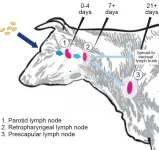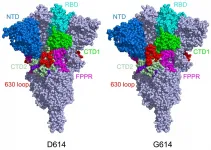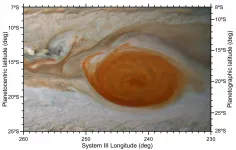This RNA molecule, cataloged in scientific databases simply as Linc00402, helps activate immune defenders known as T cells in response to the presence of foreign human cells, according to a new study by researchers at the University of Michigan Rogel Cancer Center and Michigan Medicine.
The investigation, which included samples from more than 50 patients who underwent a bone marrow or heart transplant, suggests inhibiting the RNA therapeutically might improve outcomes for transplant recipients. Their findings appear in Science Translational Medicine.
Study lead author Daniel Peltier, M.D., Ph.D., is a pediatric bone marrow transplant physician at U-M.
"We see a lot of graft-versus-host disease -- or GVHD -- which is a potentially fatal complication that can happen after transplant when T cells in the donor's blood see the transplant recipient's cells as invaders and attack them," he says. "Unfortunately, the medicines we use to prevent GVHD suppress the immune system and can raise the risk of a cancer relapse or infection, and they also have other side effects."
In taking a deep dive into the biology, Peltier and his colleagues hoped to find a way of targeting just the problematic components of the immune system that cause GVHD.
One reason for looking at this particular type of RNA molecule is that they tend to be expressed only by a limited number of tissues in a limited number of contexts, explains senior study author Pavan Reddy, M.D., deputy director of the Rogel Cancer Center and division chief of hematology/oncology at Michigan Medicine.
"So, unlike a lot of RNAs, which are expressed in all kinds of cells by all kinds of living things, long noncoding RNAs offer the possibility that we might be able to target them in a relatively unique and disease-specific way," he says.
Meaning: If doctors can find a way to zero-in and short circuit just the T cells' tendency to get aggressive in response to the transplant, they may not need to suppress the patient's immune system in a more general way that leaves them susceptible to infection or a regrowth of their cancer.
The researchers are hopeful the discoveries could also be used to help predict which patients are most likely to develop GVHD.
Finding Linc00402 Very little previous work has been done to examine the role of noncoding RNAs in human T cells, especially in clinically relevant contexts, Reddy says.
"Our lab studies bone marrow transplantation, which is a T-cell mediated process," he says. "Knowing more about how T cells work will help us make bone marrow transplants, or any immunotherapy, more efficacious."
The research project began with a database of blood samples from a range of patients who had undergone a bone marrow transplant at Michigan Medicine. Some patients had closely matched donors, while others had what doctors call mismatched donors.
"The whole idea was: If you take a T cell from one individual and put it into a different individual, what happens to its RNA profile?" Reddy says.
Then, using RNA sequencing, the research team looked for patterns across the bone marrow transplant patients. Their findings were validated in two other cohorts of patients using different methodologies.
"We wanted to make sure that what we were seeing wasn't just chance or an artifact of one approach," Reddy says. "And that's how we found this particular RNA, Linc00402. It's the one that remained consistent through the various cohorts we examined and the various ways we looked at things."
The bone marrow transplant researchers also collaborated with the lab of co-author Daniel Goldstein, M.D., director of the Michigan Biology of Cardiovascular Aging program, to see if the results held true for heart transplant patients. And it turns out they did.
"So that really told us that these long noncoding RNAs are unique to T cells that are responding to foreignness, both in the context of bone marrow transplantation and solid organ transplantation," Reddy says. "This is precisely the kind of cross-disciplinary collaboration that can only happen in a place like U-M."
Probing the mysteries of Linc00402 Since Linc00402 gets improperly activated in the presence of foreign cells, the researchers also conducted experiments to see if they saw the same response in the presence of another type of invader: a viral infection. But they didn't see elevated levels of the RNA in response to the virus.
"This strongly suggests that this dysregulation is a change you only see when you put a T cell from one human being into another," Reddy says.
Through a series of experiments, the researchers dug deeper into the RNA and its behavior. They used genetic tools like CRISPR and gapmers to silence the gene that makes it and lentiviruses to amplify it. And this revealed that Linc00402 plays a key role in T cells' ability to respond to a threat by proliferating.
In collaboration with the lab of co-author Arul Chinnaiyan, M.D., Ph.D., director of the Michigan Center for Translational Pathology, they found that within each cell, the RNA is primarily expressed in the cytoplasm.
"This led us to hypothesize that the RNA's normal function is help with cellular signaling following activation of the T cells," Peltier adds.
While many long noncoding RNAs are species-specific as well as tissue-specific, Linc00402 is present and regulates the same functions in mice. This surprising detail paves the way for animal model studies that could speed the progress of translating these laboratory discoveries toward the bedside, the researchers say. (The fact that it's conserved between species is another clue to its functional importance, Peltier notes.)
As these new details about Linc00402 are coming to light, the researchers are also proposing giving the RNA a more memorable name. In the study, they propose calling it ReLot, for regulatory long noncoding RNA of T cells.
"Scientists have only relatively recently started decoding the importance of some of these parts of the genome that don't code for proteins," Peltier says. "It's really only been since the robust sequencing of the transcriptome that we realized that the 80-90% that we thought was 'junk DNA' is definitely not junk."
INFORMATION:
Additional authors include: Molly Radosevich, Thomas Decoville, Visweswaran Ravikumar, Sethuramasundaram Pitchiaya, Sherri C. Wood, Guoqing Hou, Cynthia Zajac, Katherine Oravecz-Wilson, David Sokol, Israel Henig, Julia Wu, Stephanie Kim, Austin Taylor, Hideaki Fujiwara, Yaping Sun and Arvind Rao, all of U-M.
The research was supported by grants from the National Institutes of Health (R01-HL128046, R01-CA203542, R01-CA217156, UL1TR002240, R01-AI138347, T32HL007622-30, 5K12HD028820-27), an NCI-SPORE Career Enhancement Award, a PCF Young Investigator Award, a Department of Defense Idea Development Award and a Hope from Harper St. Baldrick's Foundation Fellowship.
Paper cited: "RNA-seq of Human T-Cells After Hematopoietic Stem Cell Transplantation Identifies Linc00402 as a Novel Regulator of T-Cell Alloimmunity," Science Translational Medicine. DOI: 10.1126/scitranslmed.aaz0316


